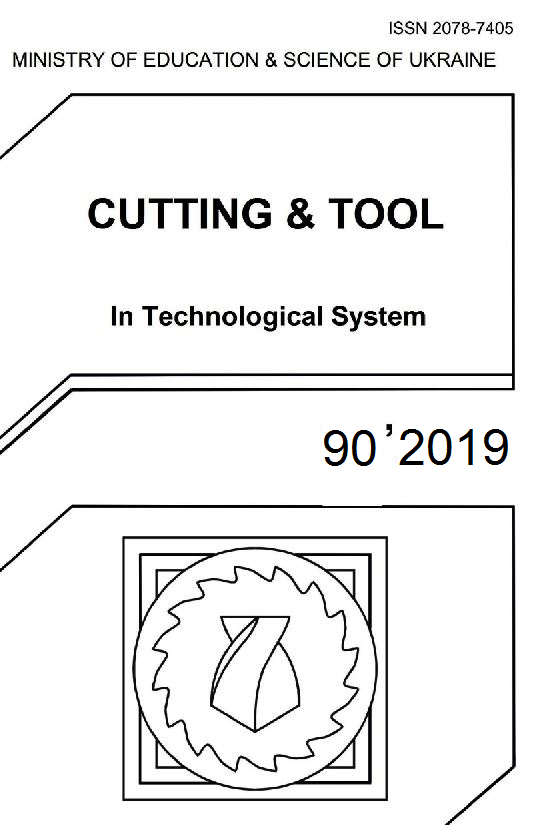CALCULATION OF THE VARIETY OF THE PLAN OF CHANGING EQUIPMENT USING WITTECER FUNCTIONS
DOI:
https://doi.org/10.20998/2078-7405.2019.90.17Keywords:
round plate, variable thickness, axisymmetric loading, bending.Abstract
Vertical cylindrical vessels and reservoirs have a large number of applications in different industries. Modernization of their construction by optimizing of structural components form is one of the most urgent priorities. Reduction of material consumption of the structure and reduction of internal stresses can be achieved by replacing of flat vessel bottoms with variable thickness vessel bottoms. Such bottoms are manufactured by stamping or by molding. At strength analysis vessel bottoms are considered as loaded round plates. Their stresses and strains can be described with equations of plate theory and can be find with analytical methods. The problem of bending of rigidly fixed variable thickness round plates is examined in the article. It is suggested that the plates are made of general-purpose constructional steel. It has been suggested by the authors that thickness of round plates increases or decreases in a radial direction exponentially, but is a constant in a circular direction. Therefore, plate deformations are axesymmetrical. Authors have introduced the new parameter that describes the radial variability of round plate thickness. The suggested parameter is provided in order to describe deformations of plano-convex, plano-concave, double convex and double concave plates. The graphical relationships between plate thickness and radial coordinate for a several number of parameter value are presented in the research. Differential equation of 4-th order for axesymmetrical deformation of round plate with exponential decrease of thickness is obtained. The equation takes into account the material properties of the round plate, its dimensions and conditions of load application. The analytic problem-solving procedure using special functions has been developed. The Whittaker functions have been selected as the special functions. The exact solution to the problem for axesymmetrically loaded round plate with exponentially variable thickness is obtained. The character and the domain of eigen functions of the differential equation are determined, the plots of eigen functions are developed. The analysis of the problem solutions with different values of the parameter of plate thickness radial variability is carried out.References
Petrov V.V. Reshenie nelineynyih zadach stroitelnoy mehaniki metodom naiskoreyshego spuska / V.V. Petrov // International Journal for Computational Civil and Structural Engineering. – 2017. – V. 13. – №3. – P. 103-111.
CHislennyie metodyi resheniya zadach stroitelnoy mehaniki: sprav. posobie / V.P. Ilin [i dr.]. – Minsk: Vyisshaya shkola, 1990. – 349 p.
Mischenko R.V., Pimenov D.A. Raschet neodnorodnyih plastin peremennoy tolschinyi metodom naiskoreyshego spuska [Elektronnyiy resurs] // Vestnik Evraziyskoy nauki. – 2018. – №1. Rejim dostupa
https://esj.today/PDF/43SAVN118.pdf
Gordon V.A., Brusova V.I. Osesimmetrichnyie deformatsii krugloy plastinki peremennoy tolschinyi s tsentralnyim jestkim vklyucheniem / V.A. Gordon, V.I. Brusova // Izv. Tulskogo gos. un-ta. Tehnicheskie nauki, 2008. – №1. – pp. 127-136.
Timoshenko S.P. Plastinki i obolochki / S.P. Timoshenko, S. Voynovskiy-Kriger. – M.: Nauka, 1966. – 636 p.
Grigorenko YA.M. Osnovi teorії plastin ta obolonok z elementami magnіtoprujnostі: pіdruchnik / YA.M. Grigorenko, L.V. Molchenko. – K.: Vid.-polіgraf. tsentr «Kyїvskiy unіversitet», 2009. – 403 p.
Koreneva E.B. Analiticheskie metodyi rascheta plastin peremennoy tolschinyi i ih prakticheskie prilojeniya / E.B. Koreneva. – Moskwa.: Izd-vo Ass. stroit. vuzov, 2009. – 240 p.
Vaynberg D.V., Vaynberg E.D. Raschet plastin /
D.V. Vaynberg, E.D. Vaynberg. – Kyiv: Budіvelnik, 1970. – 436 p.
Downloads
Published
Issue
Section
License
Copyright Notice
Authors who publish with this Collection agree to the following terms:
1. Authors retain copyright and grant the Collection right of first publication with the work simultaneously licensed under a Creative Commons Attribution License that allows others to share the work with an acknowledgement of the work's authorship and initial publication in this Collection.
2. Authors are able to enter into separate, additional contractual arrangements for the non-exclusive distribution of the Collection's published version of the work (e.g., post it to an institutional repository or publish it in a book), with an acknowledgement of its initial publication in this Collection.
3. Authors are permitted and encouraged to post their work online (e.g., in institutional repositories or on their website) prior to and during the submission process, as it can lead to productive exchanges, as well as earlier and greater citation of published work.

